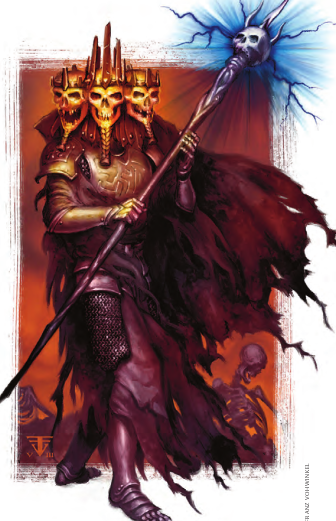Let's Read the 4e Monster Manual/Vault: Skull Lord

This article is part of a series! Click here to see the other entries.
I had never read of skull lords before reading about them here, but they have a very 3e vibe to them so likely originated there. They are only on the Monster Manual.
The Lore
Despite the imposing name and the very Metal illustration, skull lords are made to be lieutenants. They’re created by powerful necromancers or liches to command their hordes of lesser undead, so they always answer to some higher power.
The book doesn’t get into much more detail than that, but it seems to me like skull lords are created undead similar to skeletons. They were never alive and the bones are just raw materials for their creation. Unlike common skeletons, they’re sapient and quite intelligent.
The first skull lords in recorded history emerged from the ruins of the Black Tower of Vumerion. Vumerion was a “legendary human necromancer” who apparently had his career cut short by a band of intrepid adventurers, and those skull lords might have been part of his contingency plans. They roam the land looking for a way to bring their dread master back to the world.
The ritual for making skull lords eventually made its way out of those tower ruins, too, so you might find these monsters working for anyone with the stomach to make them.
Each of those three skulls anchors a different set of magic powers, and all three must be destroyed to destroy the monster itself.
The Numbers
Skull Lords are Medium Natural Humanoids with the Undead keyword, and Level 10 Artillery with a paltry 40 HP. This is not a typo, and you’ll see why soon. They have darkvision, a speed of 6, and the standard undead resistances (immunity to disease and poison, necrotic resistance, radiant vulnerability).
Skull lords project an aura (2) named Master of The Grave, which grants Regeneration 5 and a +2 bonus to saves to any undead allies inside. The aura is anchored to the Skull of Death’s Command, below, so if that’s destroyed it stops.
The skull lord’s basic attack is a Bone Staff that does a mix of physical and necrotic damage, but the three skulls are the main event. Each has an attack power that can be used as a minor action once per round, meaning the skull lord can use all of them in its turn if it doesn’t move.
The Skull of Bonechilling Fear (ranged 10 vs. Will) does a bit of cold damage and pushes 5 squares on a hit as it makes the target run away.
The Skull of Whithering Flame (ranged 10 vs. Fortitude) does fire and necrotic damage.
And the Skull of Death’s Command (Ranged 10) restores a destroyed undead minion within range. This an instance where I think the word “minion” isn’t being used as a game term, since the text also mentions the minion has “full normal hit points” when restored. So yeah, what this does is bring back an undead creature under the skull lord’s command as long as it’s level is at most the skull lord’s +2 (12 by default). The creature appears in the square where it was destroyed and stands up as a free action. It has full HP and can act normally when its next action rolls around. This is an at-will power, just like the others.
One additional effect of these Triple Skulls is that when the lord hits 0 HP, a random skull is destroyed and it instantly heals back to full. It loses the powers associated with the destroyed skull but is otherwise able to keep acting normally. This is why it only has 40 HP - it’s a multi-stage monster whose HP total is 120.
Sample Encounters and Final Impressions
The sample encounters are nothing surprising:
-
Level 10: 2 skull lords and 3 skeletal tomb guardians.
-
Level 12: 1 skull lord, 1 vampire lord, 2 zombie hulks, 9 vampire spawn bloodhunters.
Note that in both cases the skull lords could restore any of the other monsters in these encounters. If the PCs don’t learn to destroy the skull lords first, they’re gonna have a bad time.
I like these things! They look badass and can be quite dangerous.